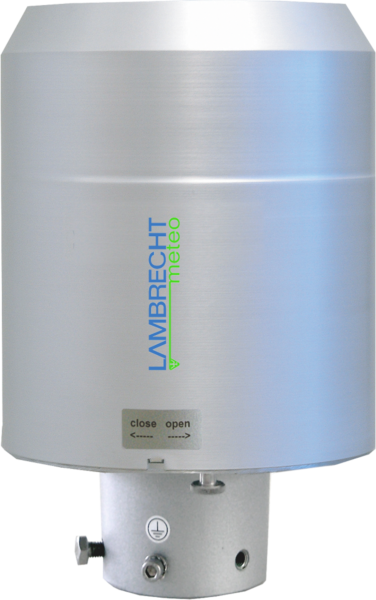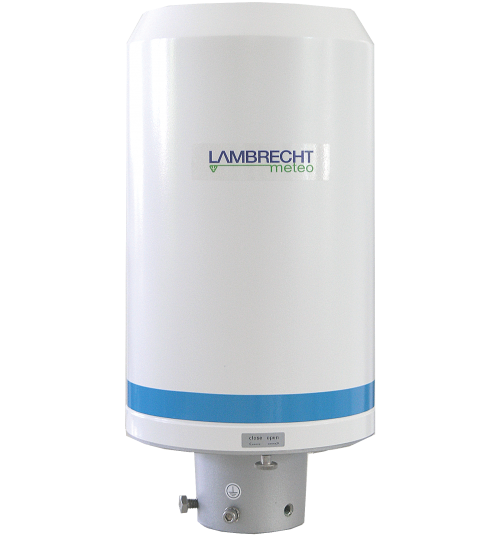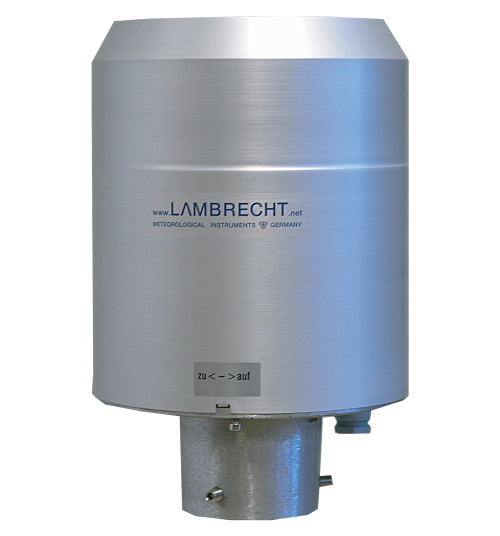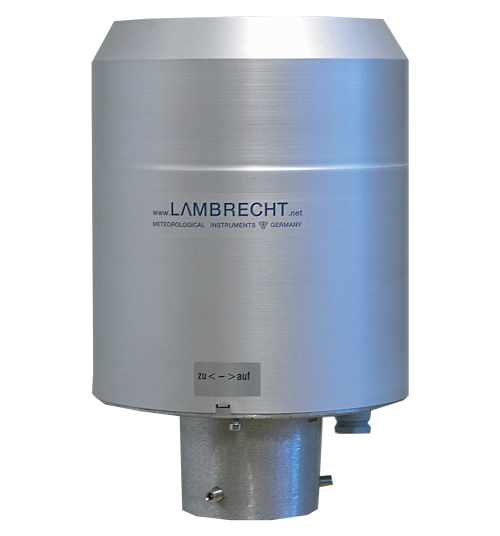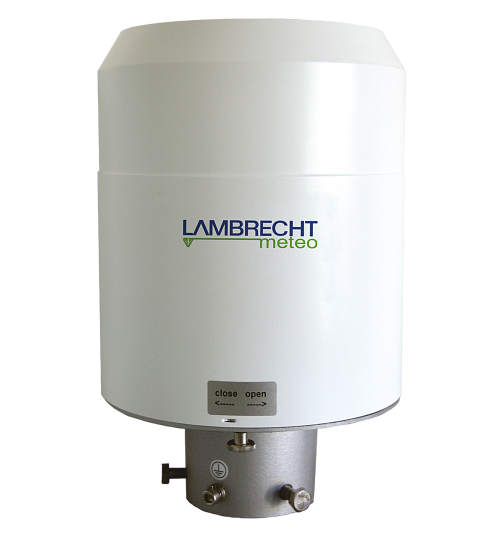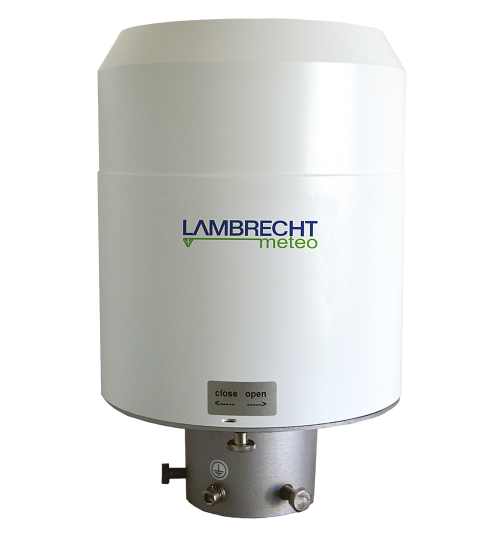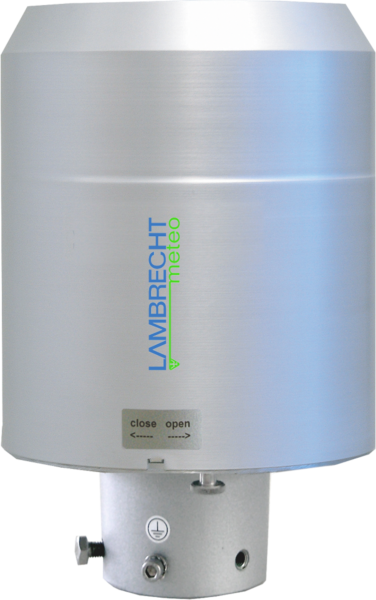Precipitation Sensor
ENVIRONMENTAL MONITORING & METEOROLOGICAL INSTRUMENTS
- rain [e] modbus weighing precipitation sensor
- rain [e] 400 weighing precipitation sensor
- rain [e] one modbus weighing precipitation sensor
- rain [e] H3 weighing precipitation sensor
- 15189 precipitation sensor
- 15189 analog precipitation sensor
- 15189 serial precipitation sensor
- rain [e] weighing precipitation sensor
- rain [e] LP weighing precipitation sensor
- rain [e] one weighing precipitation sensor
- 15235 water level sensor
rain [e] Modbus Weighing precipitation sensor
LATEST WEIGHING TECHNOLOGY …
in the smallest of spaces, combined with a self-emptying collection system, enable the rain [e] to achieve excellent resolution and accuracy. The first drop is already measured! The weighing precipitation sensor is ideal for setting up new measuring networks as well as for supplementing existing precipitation measuring networks. The Modbus RTU interface simplifies the installation of the sensor and the integration into networks.
rain [e] modbus weighing precipitation sensor features
- outstanding resolution and precision
- for checking sensors with tipping scales and other weighing systems
- compact and robust design with very low weight
- All-metal housing, weatherproof and durable
- high connectivity through diverse interfaces
- easy installation and maintenance
- professional meteorological applications
- Building automation
- Photovoltaic systems
- Industrial meteorology
![met [LOG] with met [APP] · data logger met [LOG] with met [APP] · data logger](https://www.lambrecht.net/scripts/resize.php?height=180&file=../upload/productImages/METLOG.png)
met [LOG] with met [APP] data logger
The data logger met [LOG] and the browser app met [APP] bring your climate data quickly and easily to your network (LAN). For the uncomplicated commissioning of the serial LAMBRECHT meteo sensors, the met [LOG] has an auto-configuration via plug & play.

met [APP]
The browser app in the met [LOG] for easy visualization of the current climate data in your network. And platform-independent: on your laptop, tablet or smartphone.
![Ser [LOG] · data logger Ser [LOG] · data logger](https://www.lambrecht.net/scripts/resize.php?height=180&file=../upload/productImages/SERLOG.png)
Ser [LOG] data logger
The Ser [LOG] system family gives you the greatest possible freedom for individual adjustments to your measuring tasks: expandability through modular structure, high flexibility through a large number of configuration options and many options through state-of-the-art communication interfaces.
rain [e] 400 Weighing precipitation sensor
The latest weighing technology in the smallest of spaces combined with a self-emptying monolithically manufactured precision rocker enable the rain [e] 400 to achieve outstanding resolution and accuracy. The first drop is already measured! The weighing precipitation sensor is ideally suited for setting up new measuring networks as well as for supplementing existing measuring networks.
rain [e] 400 weighing precipitation sensor features
- outstanding resolution and precision
- for checking sensors with tipping scales and other weighing systems
- compact and robust design with very low weight
- All-metal housing, weatherproof and durable
- high connectivity through diverse interfaces
- easy installation and maintenance
- classical meteorology and hydrology
- Weather services
- Monitoring networks for water management
- Lysimeter systems
- Sewage treatment plants
- Airports
- Traffic meteorology

Tretyakov wind protection for precipitation sensors
to reduce the measurement error due to the influence of wind.
Together with the weighing precipitation sensor rain [e] H3, the wind protection according to Tretjakov is used by the German Weather Service (DWD) at selected locations.
The windbreak ring is equipped with stainless steel blades arranged vertically in a circle. These slats can be moved horizontally and are conically joined at the base of the precipitation sensor.
The Tretyakov windbreak consists of a frame, metal lamellas and accessories for quick and easy assembly.
![met [LOG] with met [APP] · data logger met [LOG] with met [APP] · data logger](https://www.lambrecht.net/scripts/resize.php?height=180&file=../upload/productImages/METLOG.png)
met [LOG] with met [APP] data logger
The data logger met [LOG] and the browser app met [APP] bring your climate data quickly and easily to your network (LAN). For the uncomplicated commissioning of the serial LAMBRECHT meteo sensors, the met [LOG] has an auto-configuration via plug & play.

met [APP]
The browser app in the met [LOG] for easy visualization of the current climate data in your network. And platform-independent: on your laptop, tablet or smartphone.
![Ser [LOG] · data logger Ser [LOG] · data logger](https://www.lambrecht.net/scripts/resize.php?height=180&file=../upload/productImages/SERLOG.png)
Ser [LOG] data logger
The Ser [LOG] system family gives you the greatest possible freedom for individual adjustments to your measuring tasks: expandability through modular structure, high flexibility through a large number of configuration options and many options through state-of-the-art communication interfaces.
rain [e] one Modbus Weighing precipitation sensor
The latest weighing technology in the smallest of spaces combined with a self-emptying collection system enable the rain [e] one Modbus to achieve excellent resolution and accuracy. The first drop is already measured!
The weighing precipitation sensor is already preconfigured for easy integration into your Modbus RTU system. This simplifies the installation work enormously.
rain [e] one modbus weighing precipitation sensor features
- outstanding resolution and precision
- compact and robust design with very low weight
- All-metal housing, weatherproof and durable
- easy installation and maintenance
- Industrial applications
- SCADA systems
- Large-scale photovoltaic systems
- Power grids

Tretyakov wind protection for precipitation sensors
to reduce the measurement error due to the influence of wind.
Together with the weighing precipitation sensor rain [e] H3, the wind protection according to Tretjakov is used by the German Weather Service (DWD) at selected locations.
The windbreak ring is equipped with stainless steel blades arranged vertically in a circle. These slats can be moved horizontally and are conically joined at the base of the precipitation sensor.
The Tretyakov windbreak consists of a frame, metal lamellas and accessories for quick and easy assembly.
![met [LOG] with met [APP] · data logger met [LOG] with met [APP] · data logger](https://www.lambrecht.net/scripts/resize.php?height=180&file=../upload/productImages/METLOG.png)
met [LOG] with met [APP] data logger
The data logger met [LOG] and the browser app met [APP] bring your climate data quickly and easily to your network (LAN). For the uncomplicated commissioning of the serial LAMBRECHT meteo sensors, the met [LOG] has an auto-configuration via plug & play.

met [APP]
The browser app in the met [LOG] for easy visualization of the current climate data in your network. And platform-independent: on your laptop, tablet or smartphone.
![Ser [LOG] · data logger Ser [LOG] · data logger](https://www.lambrecht.net/scripts/resize.php?height=180&file=../upload/productImages/SERLOG.png)
Ser [LOG] data logger
The Ser [LOG] system family gives you the greatest possible freedom for individual adjustments to your measuring tasks: expandability through modular structure, high flexibility through a large number of configuration options and many options through state-of-the-art communication interfaces.
rain [e] H3 Weighing precipitation sensor
Thanks to innovative weighing technology combined with a self-emptying collecting vessel, the rain [e] set new standards in professional precipitation measurement. Its outstanding resolution and accuracy are recognized worldwide. The rain [e] H3 with electronically controlled ring heating is designed for extremely cold climates. Integrated outside temperature sensor, real-time clock, electronic monitoring when opening the housing and remote maintenance are features of constant further development. With an optional port server and web interface, the rain [e] H3 is also ideally equipped for future communication requirements.
WHAT IS AN OMBROMETER?
An ombrometer is a device for determining the amount and intensity of precipitation with a defined collection area. The precipitate is collected via the funnel and a standardized collecting area, solid precipitates such as. B. snow, are defrosted. The collected precipitate passes through the funnel through the drop former into the self-emptying collecting vessel, where it is immediately weighed. It is not the absolute weight that is evaluated, but the weight gain from the previous measurement.
ADVANTAGES AND FUNCTIONS OF THE OMBROMETER
If one chamber of the collecting vessel is full, the collecting vessel tilts, empties itself and the measurement is continued in the other chamber. During the tilting process, the ombrometer performs appropriate compensation calculations . In the subsequent filter stages, influences from wind, shock and vibration are filtered out. Because of this and the funnel , the ombrometer is almost insensitive to wind. After the filtering, the measured weight increase is evaluated and, in the simplest case, output as a rain event. An ombrometer of the rain [e] series enables the measurement of every drop of the drop former with a high resolution of 0.001 mm / m² and is smaller and more compact than many other ombrometers.
rain [e] H3 weighing precipitation sensor features
- electronically controlled ring, funnel and drain heating
- outstanding resolution and precision
- All-metal housing, weatherproof and durable
- easy installation and maintenance
- classical meteorology and hydrology
- Measuring networks
- Weather services

Tretyakov wind protection for precipitation sensors
to reduce the measurement error due to the influence of wind.
Together with the weighing precipitation sensor rain [e] H3, the wind protection according to Tretjakov is used by the German Weather Service (DWD) at selected locations.
The windbreak ring is equipped with stainless steel blades arranged vertically in a circle. These lamellas can be moved horizontally and are conically joined at the base of the precipitation sensor.
The Tretyakov windbreak consists of a frame, metal lamellas and accessories for quick and easy assembly.
![Ser [LOG] · data logger Ser [LOG] · data logger](https://www.lambrecht.net/scripts/resize.php?height=180&file=../upload/productImages/SERLOG.png)
Ser [LOG] data logger
The Ser [LOG] system family gives you the greatest possible freedom for individual adjustments to your measuring tasks: expandability through modular structure, high flexibility through a multitude of configuration options and many options through state-of-the-art communication interfaces.
Ser [LOG] can be expanded to a total of 3 analog / digital measuring modules AnDiMod. Up to 36 differential, analog channels and 11 digital channels are then available.
![met [LOG] with met [APP] · data logger met [LOG] with met [APP] · data logger](https://www.lambrecht.net/scripts/resize.php?height=180&file=../upload/productImages/METLOG.png)
met [LOG] with met [APP] data logger
The data logger met [LOG] and the browser app met [APP] bring your climate data quickly and easily to your network (LAN). For the uncomplicated commissioning of the serial LAMBRECHT meteo sensors, the met [LOG] has an auto configuration via plug & play.

met [APP]
The browser app in the met [LOG] for easy visualization of the current climate data in your network. And platform-independent: on your laptop, tablet or smartphone.
15189 Precipitation sensor according to Joss-Tognini-15189
GROWN FROM EXPERIENCE …
and equipped with the properties and advantages of its tried and tested predecessors, this all-metal tipping bucket precipitation sensor (15189) is the “best in its class”! Its functionality is precisely tailored to the needs of classical meteorology and hydrology as well as semi-professional industrial meteorology. The precipitation sensor (15189), in its different versions, is an extremely economical investment for life!
RAIN GAUGE
The precipitation gauge works with a low-friction rocker (tipping bucket) according to Joss-Tognini. With other rocker measuring systems, errors occur due to incomplete dripping due to surface tension in the precipitation. However, the rocker construction according to Joss-Tognini is designed in such a way that such errors are automatically compensated .
The rocker volume is 2 cm3 (2 g) or 4 cm³ (4 g) of water. In relation to the collecting area of 200 cm2 (WMO standard), a rocker filling corresponds to the amount of precipitation of 0.1 mm or 0.2 mm per square meter.
When the rocker is tilted, a reed contact built into the precipitation sensor is closed. The impulse output can be scanned electronically, transmitted remotely and registered. Depending on the wiring, the signal is debounced by means of integrated electronics. The signal of the reed contact can also be made available directly, ie not debounced, if the debouncing function is taken over by a suitable data logger.
RAIN GAUGE WITH HIGH QUALITY MATERIALS
Due to the use of extremely weather-resistant, high-quality materials, such as a precision stainless steel rocker and an overall metal housing , the precipitation gauge 15189 from LAMBRECHT meteo has a long service life and can also be used without hesitation in extreme climatic conditions . An integrated heater ensures that the rain gauge does not ice up in winter temperatures
- Best value for money in its class!
- Single device or part of an automatic weather station
- very reliable and durable rocker measuring system
- high-quality materials
- easy installation
- can be connected to Lambrecht data loggers met [LOG], Ser [LOG], PreLOG, TROPOS and SYNMET
- classical meteorology and hydrology
- Agricultural meteorology
- Monitoring networks for water management
- Lysimeter systems
- Sewage treatment plants
- Weather services
- Airports
- Traffic meteorology

PreLOG data logger
for most precipitation sensors with tipping bucket and reed switch output. In addition, the PreLOG can be used as an independent pulse counter.
The rechargeable battery of the PreLOG allows a reliable operating time of up to 5 years. The logger is configured, read out and also charged via the mini USB interface.
The PreLOG can communicate via GPRS via a modem, which it also uses to send alarm messages in the event of an alarm.
PreLOG ECO is the cost-effective variant for manual reading out of the data.
![met [LOG] with met [APP] · data logger met [LOG] with met [APP] · data logger](https://www.lambrecht.net/scripts/resize.php?height=180&file=../upload/productImages/METLOG.png)
met [LOG] with met [APP] data logger
The data logger met [LOG] and the browser app met [APP] bring your climate data quickly and easily to your network (LAN). For the uncomplicated commissioning of the serial LAMBRECHT meteo sensors, the met [LOG] has an auto-configuration via plug & play.

met [APP]
The browser app in the met [LOG] for easy visualization of the current climate data in your network. And that platform-independent: on your laptop, tablet or smartphone.
15189 analog Precipitation sensor according to Joss-Tognini
The robust and elegant sensor has a linearized pulse output for high accuracy and for easy connection to external data loggers! Its selectable, analog output signal simplifies the connection to PLC systems significantly. Versions suitable for winter and a long service life in general are achieved through the use of extremely weather-resistant materials.
- adjustable measuring ranges as well as absolute or sliding sums for the analog output signals
- Sensor as a single device or for automatic weather stations
- very reliable and durable weighing rocker measuring system
- high-quality materials
- simple installations
- can be connected to Lambrecht data loggers met [LOG], Ser [LOG], PreLOG, TROPOS and SYNMET
- classical meteorology and hydrology
- Agricultural meteorology
- Monitoring networks for water management
- Lysimeter systems
- Sewage treatment plants
- Weather services
- Airports
- Traffic meteorology

PreLOG data logger
for most precipitation sensors with tipping bucket and reed switch output. In addition, the PreLOG can be used as an independent pulse counter.
The rechargeable battery of the PreLOG allows a reliable operating time of up to 5 years. The logger is configured, read out and also charged via the mini USB interface.
The PreLOG can communicate via GPRS via a modem, which it also uses to send alarm messages in the event of an alarm.
PreLOG ECO is the cost-effective variant for manual reading out of the data.
![met [LOG] with met [APP] · data logger met [LOG] with met [APP] · data logger](https://www.lambrecht.net/scripts/resize.php?height=180&file=../upload/productImages/METLOG.png)
met [LOG] with met [APP] data logger
The data logger met [LOG] and the browser app met [APP] bring your climate data quickly and easily to your network (LAN). For the uncomplicated commissioning of the serial LAMBRECHT meteo sensors, the met [LOG] has an auto-configuration via plug & play.

met [APP]
The browser app in the met [LOG] for easy visualization of the current climate data in your network. And that platform-independent: on your laptop, tablet or smartphone.
15189 serial Precipitation sensor according to Joss-Tognini
THE SUCCESS SENSOR IN PRECIPITATION …
now also with serial interface. The robust and elegant sensor also has a linearized pulse output for high accuracy and for easy connection to external data loggers. The new sensor enables intensity-corrected measurement of precipitation with serial output of measured values via RS485.
- SDI-12 protocol (on RS485) for universal use
- RS485 interface
- LBP protocol (Lambrecht Bus Protocol)
- integrated intensity correction
- Calculation of the total precipitation since the last data retrieval
- Calculation of the intensity of precipitation for a sliding minute
- Calculation of precipitation intensity for a sliding hour (in minute intervals)
- System supplier
- classical meteorology and hydrology
- Monitoring networks for water management
- Sewage treatment plants
- Traffic meteorology

PreLOG data logger
for most precipitation sensors with tipping bucket and reed switch output. In addition, the PreLOG can be used as an independent pulse counter.
The rechargeable battery of the PreLOG allows a reliable operating time of up to 5 years. The logger is configured, read out and also charged via the mini USB interface.
The PreLOG can communicate via GPRS via a modem, which it also uses to send alarm messages in the event of an alarm.
PreLOG ECO is the cost-effective variant for manual reading out of the data.
![met [LOG] with met [APP] · data logger met [LOG] with met [APP] · data logger](https://www.lambrecht.net/scripts/resize.php?height=180&file=../upload/productImages/METLOG.png)
met [LOG] with met [APP] data logger
The data logger met [LOG] and the browser app met [APP] bring your climate data quickly and easily to your network (LAN). For the uncomplicated commissioning of the serial LAMBRECHT meteo sensors, the met [LOG] has an auto-configuration via plug & play.

met [APP]
The browser app in the met [LOG] for easy visualization of the current climate data in your network. And that platform-independent: on your laptop, tablet or smartphone.
rain [e] Weighing precipitation sensor
THE FIRST OF A NEW KIND
rain [e] is a new type of precipitation sensor: Highest resolution combined with a very compact design.
The unique self-draining collection system enables the measurement of every single drop with the high resolution of 0.001 mm / m 2 . The rain [e] can be operated all year round without antifreeze and is therefore particularly environmentally friendly.
rain [e] is easy to lift, transport, install and maintain. The small packing volume and the low weight ensure minimal logistical effort.
The rain [e] series is compatible with data loggers from OTT and Campbell Scientific and ideal for setting up and expanding precipitation measurement networks.
PLUVIOMETER / WEIGHING PRECIPITATION SENSOR
A pluviometer or a weighing precipitation sensor is a device for determining the amount and intensity of precipitation with a defined collection area. Using a funnel, the precipitation is collected in a collecting vessel in a simple pluviometer so that the amount of precipitation can be read off on a scale. With a weighing pluviometer, the precipitate is formed into predefined drops, which are then weighed.
ADVANTAGES AND DETAILS OF THE PLUVIOMETER
The advantage of a pluviometer of the rain [e] series is, among other things, the continuously self- emptying collection system: If one chamber of the collecting vessel is full, the collecting vessel tilts, empties itself and the measurement is continued in the other chamber. During the tilting , the pluviometer carries out appropriate compensation calculations . The device also monitors its interior temperature and uses it to compensate for the temperature drift of the load cell. In the subsequent filter stages, influences from wind, shock and vibration are filtered out. Because of this and the funnel , the weighing precipitation sensor is almost insensitive to wind.After filtering, the measured weight gain is evaluated and, in the simplest case, output as a rain event. A weighing precipitation sensor or pluviometer of the rain [e] series enables the measurement of every drop of the drop former with a high resolution of 0.001 mm / m² and is smaller and more compact than many other pluviometers.
- Amazing resolution and precision
- Checking precipitation sensors with tipping scales and other weighing systems
- Compact and robust design with very low weight
- All-metal housing, weatherproof and durable
- Best connectivity through diverse interfaces
- Easy installation and maintenance
- classical meteorology and hydrology
- Weather services
- Monitoring networks for water management
- Lysimeter systems
- Sewage treatment plants
- Airports
- Traffic meteorology

Tretyakov wind protection for precipitation sensors
to reduce the measurement error due to the influence of wind.
Together with the weighing precipitation sensor rain [e] H3, the wind protection according to Tretjakov is used by the German Weather Service (DWD) at selected locations.
The windbreak ring is equipped with stainless steel blades arranged vertically in a circle. These lamellas can be moved horizontally and are conically joined at the base of the precipitation sensor.
The Tretyakov windbreak consists of a frame, metal lamellas and accessories for quick and easy assembly.
- Durable draft shield made of corrosion-resistant V4A stainless steel
- different measuring heights available
- for all common precipitation sensors
- easy installation
rain [e] LP Weighing precipitation sensor
MINIMAL ENERGY CONSUMPTION
rain [e] is a new type of precipitation sensor: Highest resolution combined with a very compact design. The low power (LP) version of the sensor is ideal for solar or battery-operated applications. The unique self-draining collection system enables the measurement of every single drop with the high resolution of 0.001 mm / m 2 . The rain [e] can be operated all year round without antifreeze and is therefore particularly environmentally friendly.
rain [e] LP is easy to lift, transport, install and maintain. The small packing volume and the low weight ensure minimal logistical effort. The rain [e] series is compatible with data loggers from OTT and Campbell Scientific and ideal for setting up and expanding precipitation measurement networks.
- amazing resolution and precision
- Checking precipitation sensors with tipping scales and other weighing systems
- compact and robust design with very low weight
- All-metal housing, weatherproof and durable
- easy installation and maintenance
- Agricultural measurement networks
- Traffic meteorology
- Measurement networks of water suppliers
- Sewage treatment plants

Tretyakov wind protection for precipitation sensors
to reduce the measurement error due to the influence of wind.
Together with the weighing precipitation sensor rain [e] H3, the wind protection according to Tretjakov is used by the German Weather Service (DWD) at selected locations.
The windbreak ring is equipped with stainless steel blades arranged vertically in a circle. These lamellas can be moved horizontally and are conically joined at the base of the precipitation sensor.
The Tretyakov windbreak consists of a frame, metal lamellas and accessories for quick and easy assembly.
- Durable draft shield made of corrosion-resistant V4A stainless steel
- different measuring heights available
- for all common precipitation sensors
- easy installation
![Ser [LOG] · data logger Ser [LOG] · data logger](https://www.lambrecht.net/scripts/resize.php?height=180&file=../upload/productImages/SERLOG.png)
Ser [LOG] data logger
The Ser [LOG] system family gives you the greatest possible freedom for individual adjustments to your measuring tasks: expandability through modular structure, high flexibility through a multitude of configuration options and many options through state-of-the-art communication interfaces.
Ser [LOG] can be expanded to a total of 3 analog / digital measuring modules AnDiMod. Up to 36 differential, analog channels and 11 digital channels are then available.
![met [LOG] with met [APP] · data logger met [LOG] with met [APP] · data logger](https://www.lambrecht.net/scripts/resize.php?height=180&file=../upload/productImages/METLOG.png)
met [LOG] with met [APP] data logger
The data logger met [LOG] and the browser app met [APP] bring your climate data quickly and easily to your network (LAN). For the uncomplicated commissioning of the serial LAMBRECHT meteo sensors, the met [LOG] has an auto-configuration via plug & play.

met [APP]
The browser app in the met [LOG] for easy visualization of the current climate data in your network. And platform-independent: on your laptop, tablet or smartphone.
rain [e] one Weighing precipitation sensor
THE ENTRY-LEVEL MODEL IN THE RAIN [E] SERIES
The reasonably priced rain [e] one is characterized by first-class, proven quality and features as in the upper class of the rain [e] series. There are only minor differences in the technical data (amount and intensity of all precipitation).
The latest weighing technology in the smallest of spaces combined with a self-emptying collection system also enable the rain [e] one to achieve excellent resolution and accuracy.
The weighing precipitation sensor is ideal for setting up new measuring networks as well as for supplementing existing precipitation measuring networks. The Modbus RTU interface simplifies the installation of the sensor and the integration into networks.
WEIGHING PRECIPITATION SENSOR
With a weighing precipitation sensor, the precipitation is collected via a funnel and a standardized collecting area, with solid precipitation such as hail or snow being thawed with the help of a built-in heater. The precipitation collected in this way is shaped into predefined drops in the weighing precipitation sensor, which are then weighed in order to be able to measure or calculate the amount and intensity of precipitation.
WEIGHING PRECIPITATION SENSOR – DETAILS
If one chamber of the collecting vessel is full, the collecting vessel tilts, empties itself and the measurement is continued in the other chamber. During the tilting , the weighing precipitation sensor carries out corresponding compensation calculations. The device also monitors its interior temperature and uses it to compensate for the temperature drift of the load cell. In the subsequent filter stages, influences from wind, shock and vibration are filtered out. Because of this and the funnel , the weighing precipitation sensor is almost insensitive to wind.After filtering, the measured weight gain is evaluated and, in the simplest case, output as a rain event. A weighing precipitation sensor of the rain [e] series enables the measurement of every drop of the drop former with a high resolution of 0.001 mm / m² and is smaller and more compact than many other weighing precipitation sensors.
WEIGHING PRECIPITATION SENSORS AT LAMBRECHT METEO
The weighing precipitation sensor rain [e] one from the rain [e] series from LAMBRECHT meteo is also durable and weatherproof with its all-metal housing . The small packing volume and the low weight ensure a low logistical effort and make the weighing precipitation sensor rain [e] one cheaper than other weighing precipitation sensors with the same or even better functionality.
- outstanding resolution and precision
- compact design, very low weight
- weatherproof all-metal housing
- high connectivity through diverse interfaces
- easy installation and maintenance
- classical meteorology and hydrology
- Monitoring networks for water management
- Lysimeter systems
- Sewage treatment plants
- Airports
- Traffic meteorology

Tretyakov wind protection for precipitation sensors
to reduce the measurement error due to the influence of wind.
Together with the weighing precipitation sensor rain [e] H3, the wind protection according to Tretjakov is used by the German Weather Service (DWD) at selected locations.
The windbreak ring is equipped with stainless steel blades arranged vertically in a circle. These lamellas can be moved horizontally and are conically joined at the base of the precipitation sensor.
The Tretyakov windbreak consists of a frame, metal lamellas and accessories for quick and easy assembly.
- Durable draft shield made of corrosion-resistant V4A stainless steel
- different measuring heights available
- for all common precipitation sensors
- easy installation
![Ser [LOG] · data logger Ser [LOG] · data logger](https://www.lambrecht.net/scripts/resize.php?height=180&file=../upload/productImages/SERLOG.png)
Ser [LOG] data logger
The Ser [LOG] system family gives you the greatest possible freedom for individual adjustments to your measuring tasks: expandability through modular structure, high flexibility through a multitude of configuration options and many options through state-of-the-art communication interfaces.
Ser [LOG] can be expanded to a total of 3 analog / digital measuring modules AnDiMod. Up to 36 differential, analog channels and 11 digital channels are then available.
![met [LOG] with met [APP] · data logger met [LOG] with met [APP] · data logger](https://www.lambrecht.net/scripts/resize.php?height=180&file=../upload/productImages/METLOG.png)
met [LOG] with met [APP] data logger
The data logger met [LOG] and the browser app met [APP] bring your climate data quickly and easily to your network (LAN). For the uncomplicated commissioning of the serial LAMBRECHT meteo sensors, the met [LOG] has an auto-configuration via plug & play.

met [APP]
The browser app in the met [LOG] for easy visualization of the current climate data in your network. And platform-independent: on your laptop, tablet or smartphone.
15235 Water level sensor
AGAIN SOMETHING NOBLE FROM LAMBRECHT …
for precise measurements of water levels to determine the evaporation rate. The sensitive differential pressure sensor element is integrated in the extremely robust stainless steel housing (IP68). To perform its function, the high-quality sensor is mounted on the triangular plate. This plate is placed in an evaporation pan and simply leveled using adjusting screws.
- flexible cable with pressure compensation capillary
- easy to use
- Water levels of effectively 180 mm can be measured
- 0 … 5 V output for data transfer to data logger
- corresponds to the WMO specifications for classic, hydrological applications
- classical hydrology
- classical meteorology
- Soil science
- Reservoirs, dams
- Waste management
- Science and Research
![Ser [LOG] Plus · Data logger Ser [LOG] Plus · Data logger](https://www.lambrecht.net/scripts/resize.php?height=180&file=../upload/productImages/SERLOGPLUS.png)
Ser [LOG] Plus data logger
Outstanding versatility and performance for your professional meteorological data acquisition. Ser [LOG] Plus is more than just a data logger: Due to its changeability through configuration and scaling, you can adapt Ser [LOG] Plus to the specific challenges of your daily measuring tasks.
Ser [LOG] Plus is multifunctional and grows with your requirements: The data logger can be expanded to a total of 3 measuring modules and processes up to 60 parameters. Ser [LOG] Plus is particularly communicative: a total of up to 30 data transfers are possible at the same time.
- extensive sensor library, freely configurable and scalable by the user
- Formula library and free formula parser
- Alarm system for 10 warning channels via built-in and external relays, email, SMS
- diverse options for exchanging information
- interference-proof due to shielded aluminum housing
- user-friendly with free access to all connections and controls


